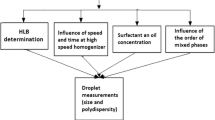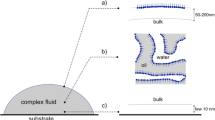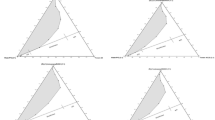Abstract
In this study, we report on the properties of water + propylene glycol/sugar surfactant/peppermint oil + ethanol. The sugar surfactants were sucrose monolaurate and sucrose dilaurate. The mixing ratios (w/w) of water/propylene glycol and that of ethanol/oil equal 2 and 1, respectively. U-type microemulsions were observed in the sucrose monolaurate while S-type microemulsions were observed in the dilaurate-based systems. Temperature-insensitive microemulsions were formulated using the two surfactants. Water volume fraction percolation thresholds were determined by the study of electrical conductivity and dynamic viscosity. The structural parameters that include the periodicity and the correlation length were estimated using small angle X-ray scattering. The periodicity increases linearly with the increase in the water content whereas the correlation length increases with the increase in the water volume fraction to a certain value then decreases. The diffusion properties investigated by nuclear magnetic resonance confirm a progressive transformation of the microemulsions from water-in-oil to bicontinuous and inversion to oil-in-water upon dilution with water. The hydrodynamic radius of diluted microemulsions measured by dynamic light scattering increases with the increase in temperature. The area per polar head group decreases with the increase in temperature.








Similar content being viewed by others
References
Fanun M (ed) (2008) Microemulsions: properties and applications. Taylor and Francis/CRC, Boca Raton
Kumar P, Mittal KL (eds) (1998) Handbook of microemulsions science and technology. Marcel Dekker, New York
Sjoblom J, Lindberg R, Friberg SE (1996) Microemulsions-phase equilibria characterization, structure, applications and chemical reactions. Adv Colloid Interface Sci 95:125–287
Moulik SP, Paul BK (1998) Structure, dynamics and transport properties of microemulsions. Adv Colloid Interface Sci 78:99–195
Solans C, Kunieda H (eds) (1997) Industrial applications of microemulsions. Surfactant science series Vol. 66. Marcel Dekker, New York
Fanun M (2008) A study of the properties of mixed nonionic surfactants microemulsions by NMR, SAXS, viscosity and conductivity. J Mol Liq 142:103–110
Fanun M (2007) Conductivity, viscosity, NMR and diclofenac solubilization capacity studies of mixed nonionic surfactants microemulsions. J Mol Liq 135:5–13
Fanun M, Salah Al-Diyn W (2007) Structural transitions in the system water/mixed nonionic surfactants/R (+)-limonene studied by electrical conductivity and self-diffusion-NMR. J Dispers Sci Technol 28:165–174
Kunieda H, Ozawa K, Huang KL (1998) Effect of oil on the surfactant molecular curvatures in liquid crystals. J Phys Chem B 102:831–837
Aramaki K, Kunieda H (1999) Solubilization of oil in a mixed cationic liquid crystal. Colloid Polym Sci 277:34–40
Glatter O, Orthaber D, Stradner A, Scherf G, Fanun M, Garti N, Clement V, Leser ME (2001) Sugar ester non-ionic microemulsions: structural characterization. J Colloid Interface Sci 241:215
Fanun M, Wachtel E, Antalek B, Aserin A, Garti N (2001) A study of the microstructure of four-component sucrose ester microemulsions by SAXS and NMR. Colloids Surf A 180:173–186
Lehmann L, Keipert S, Gloor M (2001) Effects of microemulsions on the stratum corneum and hydrocortisone penetration. Eur J Pharm Biopharm 52:129–136
Zhang H, Feng F, Fu X, Du Y, Zhang L, Zheng X (2007) Antimicrobial effect of food-grade GML microemulsions against Staphylococcus aureus. Eur Food Res Technol 226:281–286
Garti N, Clement V, Fanun M, Leser ME (2000) Some characteristics of sugar ester nonionic microemulsions in view of possible food applications. J Agric Food Chem 48:3945–3956
Khiew PS, Huang NM, Radiman S, Ahmad S (2004) Synthesis of NiS nanoparticles using a sugar-ester nonionic water-in-oil microemulsion. Mater Lett 58:762–767
Kahlweit M, Strey R, Busse G (1990) Microemulsions: a qualitative thermodynamic approach. J Phys Chem 94:3881–3894
Kahlweit M, Strey R, Schomacker R, Hasse D (1989) General patterns of the phase behavior of mixtures of water, nonpolar solvents, amphiphiles, and electrolytes. 2. Langmuir 5:305–315
Schubert KV, Kaler E (1996) Nonionic microemulsions. Ber Bunsenges Phy Chem 100:190
Kahlweit M, Strey R, Haase D, Kunieda H, Schmeling T, Faulhaber B, Borkovec M, Eicke HF, Busse G, Eggers F, Funck T, Richmann H, Magid L, Soderman O, Stilbs P, Winkler J, Dittrich A, Jahn W (1987) How to study microemulsions? J Colloid Interface Sci 118:436–453
Berghenholtz J, Romagnoli A, Wagner N (1995) Viscosity, microstructure, and interparticle potential of AOT/H2O/n-decane inverse microemulsions. Langmuir 1:1559–1570
Feldman Y, Kozlovich N, Nir I, Garti N (1995) Dielectric relaxation in sodium bis(2-ethylhexyl) sulfosuccinate–water–decane microemulsions near the percolation temperature threshold. Phys Rev E 51:478–491
Cametti C, Codastefano P, Tartaglia P, Chen SH, Rouch J (1992) Electrical conductivity and percolation phenomena in water-in-oil microemulsions. J Phys Rev A 45:R5358–R5361
Eicke HF, Meier W, Hammerich H (1994) On electric conductivity of infinite clusters in water-in-oil microemulsions. Langmuir 10:2223–2227
Lake JA (1967) An iterative method of slit-correcting small angle X-ray data. Acta Crystallogr A 23:191–194
Teubner M, Strey R (1987) Origin of the scattering peak in microemulsions. J Chem Phys 87:3195
Teukolsky SA, Vetterling WT, Flannery BP (1992) Numerical recipes in C: the art of scientific computing. Cambridge University Press, New York
Brunner-Popela J, Mittelbach R, Strey R, Schubert KV, Kaler EW, Glatter O (1999) Small-angle scattering of interacting particles. III. D2O-C12E5 mixtures and microemulsions with n-octane. J Chem Phys 21:10623
Wu D, Chen A, Johnson CS (1995) An improved diffusion-ordered spectroscopy experiment incorporating bipolar-gradient pulses. J Magn Reson 115:260–264
Stejskal EO (1995) In: Stejskal EO (ed) Encyclopedia of nuclear magnetic resonance. Wiley, New York, pp 657–658
Koppel DE (1972) Analysis of macro molecular polydispersity in intensity correlation spectroscopy: the method of cumulants. J Chem Phys 57:4814–4820
Provencher SW (1979) Inverse problems in polymer characterisation: direct analysis of polydispersity with photon correlation spectroscopy. Macromol Chem 180:201–209
Pes MA, Aramaki K, Nakamura N, Kunieda H (1996) Temperature-insensitive microemulsionsin a sucrose monoalkanoate system. J Colloid Interface Sci 178:666
Fanun M (2009) Microemulsion formation on water/nonionic surfactant/peppermint oil mixtures. J Dispers Sci Technol 30(3):289–296
Strey R (1996) I. Experimental facts water-nonionic surfactant systems, the effect of additives. Ber Bunsenges Phys Chem 100:182–189
Yaghmur A, Aserin A, Garti N (2002) Phase behavior of microemulsions based on food-grade nonionic surfactants: effect of polyols and short-chain alcohols. Colloids Surf A 209:71–81
Garti N, Aserin A, Fanun M (2000) Non-ionic sucrose esters microemulsions for food applications, part I: Water solubilization. Colloids Surf A 164:27–38
Stilbs P, Lindman B (1983) Effect of alcohol cosurfactant length on microemulsion structure. J Colloid Interface Sci 95:583–585
Alany RG, Rades T, Agatonovic-Kustin S, Davies NM, Tucker IG (2000) Effects of alcohols and diols on the phase behaviour of quaternary systems. Int J Pharm 196:141
Safran SA, Grest GS, Bug A, Webman I (1987) I. Percolation in interacting microemulsions. In: Rosano H, Clausse M (eds) Microemulsion systems. Marcel Dekker, New York, pp 235–245
De Gennes PG, Taupin C (1990) Microemulsions and the flexibility of oil/water interfaces. J Phys Chem 94:8407–8413
Grest G, Webman I, Safran S, Bug A (1986) Dynamic percolation in microemulsions. Phys Rev A 33:2842–2845
Djordjevic L, Primorac M, Stupar M, Krajisnik D (2004) In vitro release of diclofenac diethylamine from caprylocaproyl macrogloglycerides based microemulsions. Int J Pharm 271:11–19
Mehta SK, Dewan RK, Bala K (1994) Percolation phenomenon and the study of conductivity, viscosity, and ultrasonic velocity in microemulsions. Phys Rev E 50:4759–4762
Ajith S, Rakshit AK (1995) Effect of NaCl on a nonionic surfactant microemulsion system. Langmuir 11:1122–1126
Rakshit AK, Ajith S (1995) Studies of mixed surfactant microemulsion systems: Brij 35 with Tween 20 and sodium dodecyl sulfate. J Phys Chem 99:14778–14783
Peyrelasse J, Boned C (1990) Conductivity, dielectric relaxation, and viscosity of ternary microemulsions: the role of the experimental path and the point of view of percolation theory. Phys Rev A 41:938–953
Nilsson PG, Lindman B (1983) Water self-diffusion in nonionic surfactant solution. Hydration and obstruction effects. J Phys Chem 87:4756–4761
Lindman B, Shinoda K, Jonstromer M, Shinohara A (1988) A change of organized solution (microemulsion) structure with small changes in surfactant composition as revealed by NMR self-diffusion studies. J Phys Chem 92:4702–4706
Bastogne F, Nagy BJ, David C (1999) Quaternary ‘N-alkylaldonamide-brine-decane-alcohol’ systems. Part II: microstructure of the one-phase microemulsion by NMR spectroscopy. Colloids Surf A 148:245–257
El-Seoud O (1997) Use of NMR to probe the structure of water at interfaces of organized assemblies. J Mol Liq 72:85–103
Olsson U, Nagai K, Wennerstrom H (1988) Microemulsions with nonionic surfactants. 1. Diffusion process of oil molecules. J Phys Chem 92:6675–6679
Soderman O, Nyden M (1999) NMR in microemulsions. NMR translational diffusion studies of a model microemulsion. Colloids Surf A 158:273–280
Ko CJ, Ko YJ, Kim DM, Park HJ (2003) Solution properties and PGSE-NMR self-diffusion study of C18:1E10/oil/water system. Colloids Surf A 216:55–63
Fanun M (2007) Structure probing of water/mixed nonionic surfactants/caprylic capric triglyceride. J Mol Liq 133:22–27
Fanun M, Salah Al-Diyn W (2006) Electrical conductivity and self diffusion NMR studies of the system: water/sucrose laurate/ethoxylated mono-di-glyceride/isopropylmyristate systems. Colloids Surf A 277:83–89
Arvidsson A, Soderman O (2001) The microemulsion phase in the didecyldimethylammonium bromide/dodecane/water system. Phase diagram, microstructure, and nucleation kinetics of excess oil phase. Langmuir 17:3567–3572
Author information
Authors and Affiliations
Corresponding author
Electronic supplementary materials
ESM 1
(DOC 299 kb)
Rights and permissions
About this article
Cite this article
Fanun, M. Properties of microemulsions with sugar surfactants and peppermint oil. Colloid Polym Sci 287, 899–910 (2009). https://doi.org/10.1007/s00396-009-2043-y
Received:
Revised:
Accepted:
Published:
Issue Date:
DOI: https://doi.org/10.1007/s00396-009-2043-y




